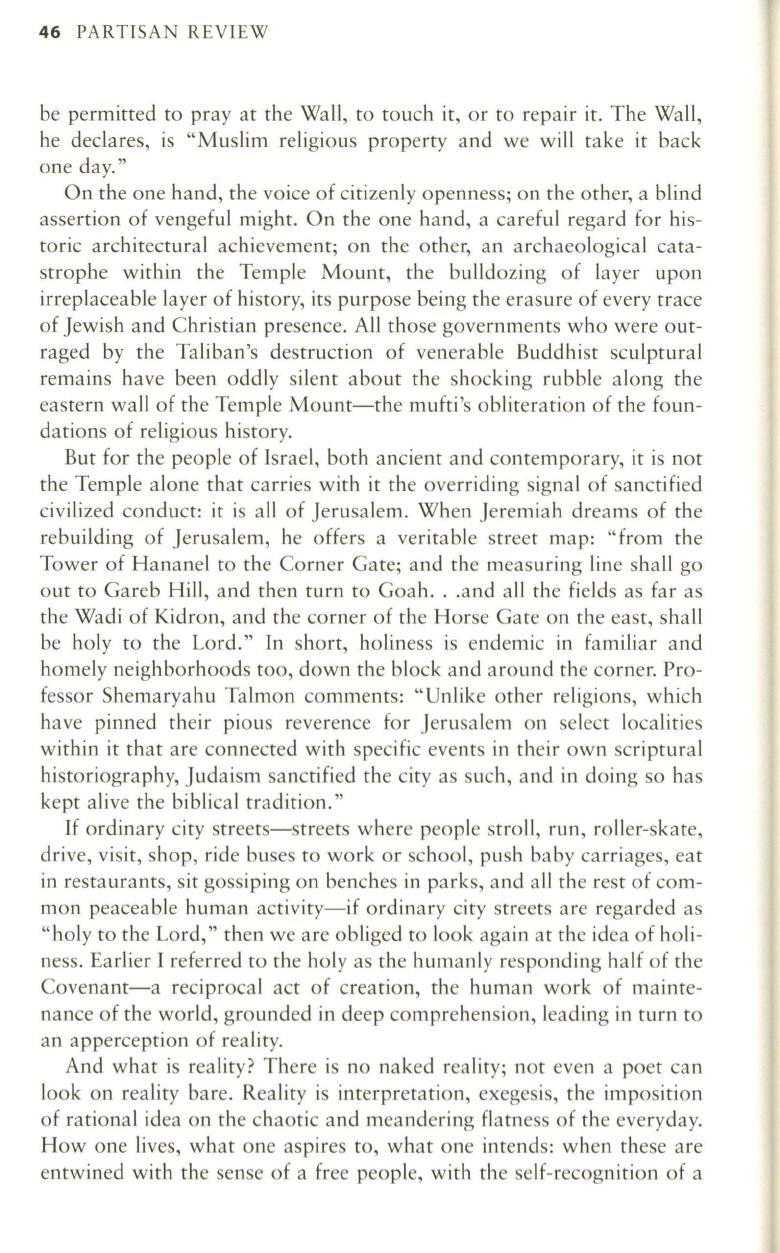
46
PARTISAN REVIEW
be permitted to pray at the Wall, to touch it, or to repair it. The Wall,
he declares, is "Muslim religious property and we will take it back
one day."
On the one hand, the voice of citizenly openness; on the other, a blind
assertion of vengefu l might. On the one hand, a careful regard for his–
toric architectural achievement; on the other, an archaeological cata–
strophe within the Temple Mount, the bulldozing of layer upon
irreplaceable layer of history, its purpose being the erasure of every trace
of Jewish and Christian presence. All those governments who were out–
raged by the Taliban's destruction of venerable Buddhist sculptural
remains have been oddly silent about the shocking rubble along the
eastern wall of the Temple Mount-the mufti's obliteration of the foun–
dations of religious history.
But for the people of Israel, both ancient and contemporary, it is not
the Temple alone that carries with it the overriding signal of sanctified
civilized conduct: it is all of Jerusalem. When Jeremiah dreams of the
rebuilding of Jerusalem, he offers a veritable street map: "from the
Tower of Hananel to the Corner Gate; and the measuring line shall go
out to Gareb Hill, and then turn to Goah.. .and all the fields as far as
the Wadi of Kidron, and the corner of the Horse Gate on the east, shall
be holy to the Lord." In short, holiness is endemic in familiar and
homely neighborhoods too, down the block and around the corner. Pro–
fessor Shemaryahu Talmon comments: "Unlike other religions, which
have pinned their pious reverence for Jerusalem on select localities
within it that are connected with specific events in their own scriptural
historiography, Judaism sanctified the city as such, and in doing so has
kept alive the biblical tradition."
If
ordinary city streets-streets where people stroll, run, roller-skate,
drive, visit, shop, ride buses to work or school, push baby carriages, eat
in restaurants, sit gossiping on benches in parks, and all the rest of com–
mon peaceable human activity-if ordinary city streets are regarded as
"holy to the Lord," then we are obliged to look again at the idea of holi–
ness. Earlier I referred to the holy as the humanly responding half of the
Covenant-a reciprocal act of creation, the human work of mainte–
nance of the world, grounded in deep comprehension, leading in turn to
an apperception of reality.
And what is reality? There is no naked reality; not even a poet can
look on reality bare. Reality is interpretation, exegesis, the imposition
of rational idea on the chaotic and meandering flatness of the everyday.
How one lives, what one aspires to, what one intends: when these are
entwined with the sense of a free people, with the self-recognition of a


